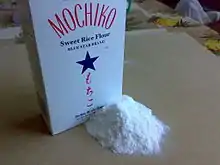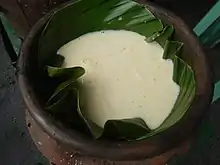Rice flour
Rice flour (also rice powder) is a form of flour made from finely milled rice. It is distinct from rice starch, which is usually produced by steeping rice in lye. Rice flour is a common substitute for wheat flour. It is also used as a thickening agent in recipes that are refrigerated or frozen since it inhibits liquid separation.

Production
Rice flour may be made from either white rice or brown rice. To make the flour, the husk of rice or paddy is removed and raw rice is obtained, which is then ground to flour.
Types
East Asia
In China, rice flour is called zhānmǐfěn (粘米粉) and glutinous rice flour is called nuòmǐfěn (糯米粉).
In Japan, rice flour is called komeko (米粉) and is available two forms: glutinous and non-glutinous.[1] The glutinous rice is also called sweet rice, but despite these names it is neither sweet nor does it contain gluten;[2] the word "glutinous" is used to describe the stickiness of the rice when it is cooked. The glutinous variety called mochigomeko (もち米粉, or mochiko for short) is produced from ground cooked glutinous rice (もち米, mochigome) and is used to create mochi or as a thickener for sauces.[3] Another variety called shiratamako (白玉粉) is produced from ground uncooked glutinous rice and is often used to produce confectioneries.[3] The non-glutinous variety called jōshinko (上新粉) is made from short-grain rice and is primarily used for creating confectioneries.[3]
In Korea, rice flour, called ssal-garu (쌀가루), usually refers to flour made from non-glutinous white japonica (short grain) rice. Glutinous rice flour is called chapssal-garu (찹쌀가루), and the specific term for non-glutinous flour is mepssal-garu (멥쌀가루). Other types of rice flour commonly used in Korean cuisine include brown rice flour (현미가루, hyeonmi-garu), and black rice flour (흑미가루, heungmi-garu). Different milling methods also produce different types of rice flour. Wet-milled rice flour (습식 쌀가루, seupsik ssal-garu) is made from rice that was soaked in water, drained, ground using a stone-mill, and then optionally sifted.[4] Like moderately moist sand, wet-milled rice flour forms an easily breakable lump when squeezed with hand. It is usually stored in freezer. Dry-milled rice flour (건식 쌀가루, geonsik ssal-garu) is made from dry rice grains and is stored on a shelf. Rice flour made from different rice varieties and with different milling methods are used for different types of tteok (rice cakes) and hangwa (confections).
Southeast Asia

In the Philippines, rice flour is not traditionally prepared dry. Rather it is made by first soaking uncooked glutinous rice overnight (usually allowing it to slightly ferment) then grinding the results (traditionally with stone mills) into a rich and smooth viscous rice dough known as galapóng. It is the basis for numerous types of native rice cakes and desserts (kakanin) in native Filipino cuisine. Depending on the dish, coconut milk (gata), wood ash lye, and various other ingredients may be added to the galapóng. The galapóng can be prepared by baking, steaming, boiling, or frying, resulting in dishes like puto or bibingka.[5]
South Asia
Rice flour has a presence in South Indian cuisine. Some of the examples include dosa, puttu, golibaje (mangalore bajji) and kori rotti. It is also mixed with wheat, millet, other cereal flours, and sometimes dried fruits or vegetables to make Manni, a kind of baby food..
It is a regular ingredient in Bangladeshi cuisine, Bengali cuisine and Assamese cuisine. It is used in making roti and desserts such as sandesh and pitha (Rice cakes or pancakes which are sometimes steamed, deep fried or pan fried and served along with grated coconut, sesame seeds, jaggery and chashni). It is also used in making Kheer (a common South Asian dessert).
In Sri Lanka, it's used in making many household food products. It is used in making food products such as pittu, appa (hoppers), indi appa (string hoppers) and sweets such as kewum, kokis, athirasa and many more. Also it can be used in making bread and other bakery products.
Balkans
Rice flour is known as pirinç unu in Turkish.
Latin America
Rice flour is also used in the Central American dish pupusas as a substitute to regular flour.
Uses
.jpg.webp)
Culinary
Rice flour can be used to make confections like rice cakes, macaroons and some types of buns due to the texture and flavor it lends the finished products. It is also used for dusting confections in a manner similar to powdered sugar.[6]
Cosmetics
Rice flour is used in the cosmetics industry.
Mushroom cultivation
Brown rice flour can be combined with vermiculite for use as a substrate for the cultivation of mushrooms. Hard cakes of colonised substrate can then be fruited in a humid container. This method is often (though not always) employed by growers of edible mushrooms, as it is a very simple and low-cost method of growing mushrooms.
References
- Hosking, Richard (1997). A Dictionary of Japanese Food. Tuttle Publishing. p. 191. ISBN 9780804820424. Retrieved 29 January 2013.
- Alden, Lori (1996). "Cook's Thesaurus: Rice". Lori Allen. Retrieved 2006-03-02.
- 辻静雄 (2006). Japanese Cooking: A Simple Art. Kodansha International. p. 70. ISBN 9784770030498. Retrieved 29 January 2013.
- Lee, Sang-Hyo; Lee, Hyun-Yu; Kim, Kil-Hwan; Kim, Young-In (1993). "Effect of Different Milling Methods on Distribution of Particle Size of Rice Flours". Korean Journal of Food Science and Technology. 25 (5): 541–545. ISSN 0367-6293.
- Amy Besa & Romy Dorotan (2014). Memories of Philippine Kitchens. Abrams. ISBN 9781613128084.
- E.B. Bennion (1997). The Technology of Cake Making. Springer. p. 15.
External links
- Japanese rice flours at Wagashi-net.de
